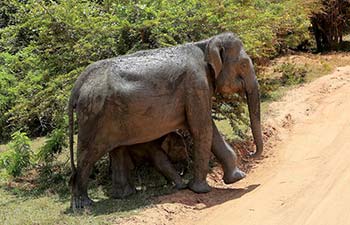SAN FRANCISCO, May 4 (Xinhua) -- An orchid fossil, trapped in Baltic amber that dates back some 45 million years to 55 million years ago, has been identified by researchers.
While the orchid family has some 28,000 species, more than double the number of bird species and quadruple the mammal species, the previous record for an orchid fossil found in Dominican amber is 20-30 million years old.
Orchids have their pollen in small sac-like structures called pollinia, which are attached by supports to viscidia, or adhesive pads, that can stick to the various body parts of pollinating insects, including bees, beetles, flies and gnats. The entire pollination unit is known as a pollinarium.
In a study published in the Botanical Journal of the Linnean Society, researchers documented that a small female fungus gnat was carrying the pollinaria of an extinct species of orchid when it became trapped in amber near what is now the Baltic Sea in northern Europe. The pollinaria was attached to the base of the gnat's hind leg.
Amber preserves fossils so well, according to the researchers, that they could identify a droplet of congealed blood at the tip of the gnat's leg, which had been broken off shortly before it was entombed in amber.
"It wasn't until a few years ago that we even had evidence of ancient orchids because there wasn't anything preserved in the fossil record," said George Poinar, Jr., a professor emeritus of entomology in the College of Science at Oregon State University (OSU) and lead author on the study. "But now we're beginning to locate pollen evidence associated with insects trapped in amber, opening the door to some new discoveries."
Orchids, which use color, odor and the allure of nectar to draw in potential pollinating insects, will emit a scent that suggests to hungry insects the promise of food, but they will learn that the promise of nourishment was false after entering the flower.
Likewise, female gnats may pick up a mushroom-like odor from many orchids, which attracts them as a place to lay their eggs because the decaying fungal tissue is a source of future nutrition. However, it is a ruse. In frustration, they may go ahead and lay their eggs, dooming their offspring to a likely death from a lack of food.
Finally, attracted by the ersatz scent of female flies, male insects will attempt to copulate with a part of the orchid they think is a potential mate.
All three of these processes are based on deception, Poinar was quoted as saying by a news release from OSU on Thursday.
"Though the deception works in different ways, the bottom line is that the orchid is able to draw in pollinating insects, which unwittingly gather pollen that becomes attached to their legs and other body parts, and then pass it on to the next orchid flowers that lure them in."

















